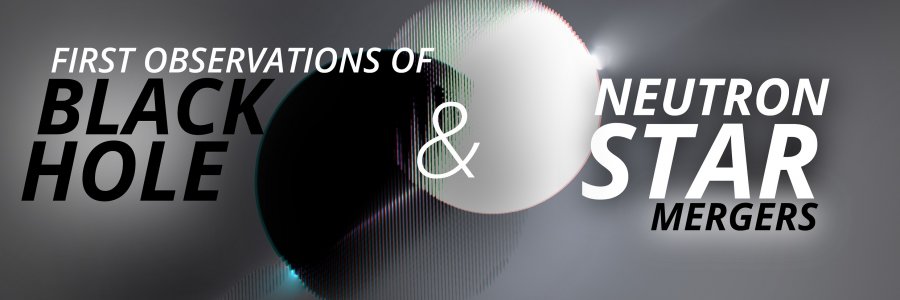
First observations of ‘mixed’ black hole and neutron star pairs
The Virgo, LIGO and KAGRA scientific collaborations today announced the first observation ever of binary systems consisting of a neutron star (NS) and a black hole (BH). This was made possible by the detection, in January 2020, of gravitational signals (nicknamed GW200105 and GW200115 from the dates of their detection) emitted by two systems, in which a black hole and a neutron star, rotating around each other, merged into a single compact object. The existence of these systems was predicted by astronomers several decades ago, but they had never been observed with confidence, either through electromagnetic or gravitational signals, until now. The result and its astrophysical implications have today been published in The Astrophysical Journal Letters.
During this time, the sensitivity of all three instruments (that is, their ability to detect signals even fainter than those observed in 2015 and 2017 or coming from similar sources, but located further away in the universe) should be improved significantly. Then, in early 2019, the data-taking period – O3 – will start and last for about one calendar year. On the Virgo side, three phases were foreseen.
"So far we have observed pairs of black holes or pairs of neutron stars through electromagnetic radiation observations or through gravitational waves. The pair of black hole and neutron star was the ‘missing binary’ astronomers were always asking about", said Astrid Lamberts, CNRS researcher of the Virgo collaboration at Artemis laboratory, Observatoire de la Côte d'Azur in Nice. "This discovery shows once again how gravitational-wave detectors are broadening our horizon, allowing us to observe what until now we literally could not see."
The gravitational signals detected in January encode valuable information about the physical features of the systems, such as the mass and distance of the two NSBH pairs, as well as about the physical mechanisms that have generated them and bring them to collapse. The signal analysis has shown that the black hole and neutron star that created GW200105 are, respectively, about 8.9 times and 1.9 times as massive as our Sun and their merger happened around 900 million years ago, hundreds of millions of years before the first dinosaurs appeared on Earth. For the GW200115 event, the Virgo, LIGO and KAGRA scientists estimate the two compact objects had masses around 5.7 (BH) and 1.5 (NS) times the Sun mass and that they merged almost 1 billion years ago.
The result announced today, alongside the dozens of detections made by Virgo and LIGO to date, allow us, for the first time, a close observation of some of the most violent and rare phenomena in the Universe and to draw an unprecedented picture of the crowded and chaotic regions that are one of the possible nursery environments of these events. Furthermore, the detailed information we have started to collect about the physics of the black hole and star mergers, gives us the chance to test the fundamental laws of physics at extreme conditions, which obviously we will never be able to reproduce on Earth. "The discovery announced today is one more gem in the treasure of the 3rd LIGO–Virgo observing run", stated Giovanni Losurdo, Virgo spokesperson and INFN researcher. "LIGO and Virgo keep unveiling catastrophic collisions, which have never been observed before, shedding light on a truly new cosmic landscape. We are now upgrading the detectors with the aim of looking much farther into the depth of the cosmos, searching for new gems, seeking a deeper understanding of the universe we live in."
How does a black hole and neutron star pair form and merge? (see Infographics)
The current astrophysical models roughly consider two main theoretical scenarios for the formation of NSBH pairs. One, called “isolated binary evolution”, starts with two stars orbiting around one another, which, at the end of their life, become, after supernova explosions, a still-bound-together black hole and neutron star. The other possibility is that the neutron star (NS) and black hole (BH) form from separate stars in unrelated supernova explosions, and only afterwards find one another. This, called “dynamical interaction”, can be triggered by different physical mechanisms in dense stellar environments, such as globular clusters, young clusters or even the accretion disks of active galactic nuclei.
Based on these different theoretical scenarios it is possible to make predictions, for example, about the orientations of the black hole and neutron star rotations with respect to the orbital motions (i.e. their so called “spins”) or, more generally, about how many NSBH pairs merge in the Universe within a given time period (a quantity called the “merger rate”).
Thanks to the detections announced today, for the first time, these predictions can be compared with the data of the two observed NSBH pairs, and we can start discriminating between the different astrophysical models.
For instance, considering that only these two NSBH events have been detected during all of the LIGO and VIRGO observing runs, it turns out that between 5 and 15 such systems merge per year within the distance of one billion light years. This rate appears to be especially consistent with both the isolated binary evolution and the dynamical interaction in young star clusters or in active galactic nuclei; however this estimated rate, as well as the measured spin values of GW200105 and GW200115, do not allow to single out just one specific formation scenario.

Image: Rainbow Swirl is an artistic image inspired by a Black Hole Neutron Star merger event.
Image credit: Carl Knox, OzGrav – Swinburne University
📖 Research article: arXiv, The Astrophysical Journal Letters
